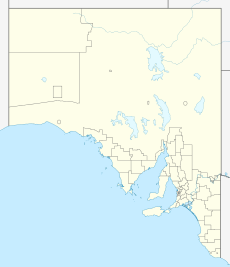Aberdour Conservation Park facts for kids
Quick facts for kids Aberdour Conservation ParkWillalooka, South Australia |
|
|---|---|
|
IUCN Category III (Natural Monument)
|
|
| Nearest town or city | Keith |
| Established | 28 February 1991 |
| Area | 1.45 km2 (0.6 sq mi) |
| Managing authorities | Department for Environment and Water |
| See also | Protected areas of South Australia |
Aberdour Conservation Park is a special protected area in South Australia. It's located in the south-east part of the state, near a place called Willalooka. The park is about 226 kilometers south-east of Adelaide and 35 kilometers south of the town of Keith. It's a great place to learn about nature and see unique plants.
Contents
About the Park
Aberdour Conservation Park is made up of two main pieces of land. These pieces are found in an area known as the Hundred of Willalooka.
A road called Cannawigara Road runs between the two parts of the park. Nankivell Road is on the eastern side. Inside the park, there's a track for fire access and an old quarry on the eastern edge.
How the Park Was Created
The park was officially created on February 28, 1991. This happened under a law called the National Parks and Wildlife Act 1972.
One part of the land was kindly given to the state government by the Nankivell family. Later, on February 16, 2006, another piece of land was added to the park. This second part used to be a stone reserve.
The park gets its name from Aberdour Homestead, which is a historic home located nearby. As of 2016, the park covers about 1.45 square kilometers, which is about the size of 145 football fields.
Why Aberdour Park is Important
In 1997, experts described the park as very important. It protects a special area of natural plants and trees that are typical of the local landscape. This landscape has rolling sand dunes and limestone.
Much of the land around the park has been cleared for other uses. Because of this, Aberdour Conservation Park is a vital home for many animals. It's especially important for birds, acting like a "stepping stone" or a safe stop-over point for them.
Plants and Wildlife
The park is home to three main types of plant groups, also called vegetation associations. These groups grow in different parts of the park.
Types of Plant Groups
- Open Scrub on Rocky Ridges: One type of plant group grows on a rocky ridge that runs through the park. Here, you'll find tall shrubs like Eucalyptus diversifolia and Eucalyptus leptophylla. Other common plants include broombush (Melaleuca uncinata), slaty sheoak (Allocasuarina muelleriana), and silver broombush (Baeckea behrii).
- Open Scrub on Sandy Soil: Another plant group is found on a small strip of sandy soil along the park's northern edge. This area has many of the same plants as the rocky ridges. However, it also features Eucalyptus incrassata trees and dryland tea-tree (Melaleuca lanceolata).
- Woodland Along the Eastern Boundary: The third plant group is a woodland area along the park's eastern side. Here, you'll see Eucalyptus fasciculosa trees, also known as Pink Gums.
Endangered Plant Species
Aberdour Conservation Park is a known home for a very special plant called the Jumping-Jack Wattle (Acacia enterocarpa). This plant is listed as endangered.
Being "endangered" means there are very few of these plants left in the wild. They are at high risk of disappearing forever. Both the National Parks and Wildlife Act 1972 and the Australian Government's Environment Protection and Biodiversity Conservation Act 1999 protect this important species.
Visiting the Park
As of 1997, the park was mainly visited by local school groups. These groups came to the park to learn about the environment and its importance.
The park is classified as an IUCN Category III protected area. This means it's a special kind of protected area that focuses on preserving natural features.


